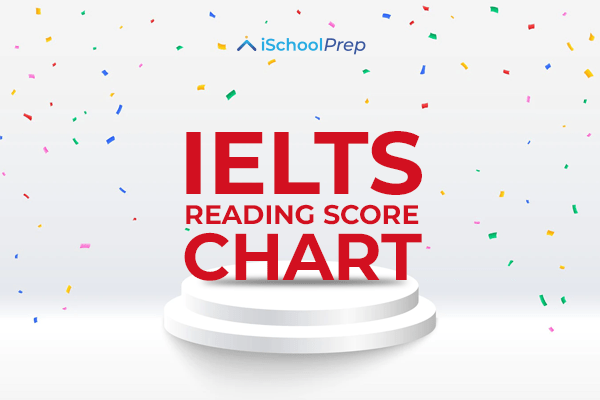Table of Contents
Importance of knowing the IELTS reading score chart!
Comprehending the format of the IELTS examination and its scoring system is a tedious task. Especially in the beginning, it may seem like a lot of work. But everything becomes far less complicated when you have clearly articulated your objectives and are aware of every step ahead of you. Hence, to help you, here are the IELTS reading score chart fundamentals and some strategies for scoring the highest band.
IELTS reading band score details
The first step in determining an individual’s IELTS general reading band score is their raw score, determined by the total number of questions answered correctly. Because there are forty questions in the academic reading part of the IELTS test, and each point is worth one point, the overall IELTS reading score chart for academics is forty.
The next step involves converting the raw point into the band score, which may vary from 0 to 9. The range of possible reading scores on the IELTS is 0 to 9, with 9 being the highest possible score and 0 being the lowest. The following IELTS reading score chart is for your reference –
| No. of correct answers | Band calculation in IELTS |
| 40-39 | 9 |
| 38-37 | 8.5 |
| 36-35 | 8 |
| 34-33 | 7.5 |
| 32-30 | 7 |
| 29-27 | 6.5 |
| 26-23 | 6 |
| 22-19 | 5.5 |
| 18-15 | 5 |
| 14-13 | 4.5 |
| 12-10 | 4 |
| 9-8 | 3.5 |
| 7-6 | 3 |
| 5-4 | 2.5 |
Popular question categories for reading assignments
Now that you know the IELTS reading score chart, let’s see what the most popular question categories in the section are. The IELTS exam’s academic and general reading sections are 60 minutes long and aim to assess your reading comprehension and fluency. There are 40 questions in each one. Time spent filling out the answer sheet is counted against 60 minutes.
The most typical question types in a reading exam are as follows-
- Multiple choice questions
- Information identification questions
- Information matching
- Head matching
- Sentence completion
- Summary completion
- Features matching
- Matching sentence endings
- Short answer questions
- Matching information
Tips for nailing the IELTS reading section
To get a band mentioned in the IELTS reading score chart, it is important that you have good preparation strategies. The most significant things you can do to improve your chances of doing well on the IELTS exam are to shift your perspective, narrow your attention, and have a more profound knowledge of the exam. Let’s discuss some strategies to help you do well on the test.
#1. Work on expanding your language skills
Ensure you begin with this step since it is the first and most essential. There were a lot of people that took the IELTS, and the majority of them said that they struggled to grasp some sections. You may need to read a piece of writing more than once to grasp its primary concepts. Doing so is the most important thing you can do to increase the quality of your answers and, ultimately, your IELTS writing exam score, which you should consider.
For a good band, as per the IELTS reading score chart, you have to practice your reading skills to improve, using effective tactics that will enable you to skim the material and easily retain what it means. Practicing these skills will help you to make progress. If you put effort into extending your vocabulary, using this strategy will be considerably more favorable.

#2. Evaluate diverse test tactics, then choose the best one
You may get a study guide for the reading portion of the test on any site and from tutors or past students. Test out a few of these methods and see which ones get the greatest practice IELTS reading score chart for you.
Some students find reading the questions easier than the text, which helps to understand the material better. Some kids behave in the other way. Put both strategies to the test on mock tests and go with the one that nets you more marks on the IELTS reading score chart.
#3. Accelerate your reading pace
If you want to maximize the effectiveness of the 60 minutes allotted for the IELTS reading section, you’ll need to work on increasing your reading speed throughout your study sessions.
Quickly navigate the page using a pointer. Instead of jumping from one word to the next as you read, try focusing on three words at once. Pick up three words at a time and then use them to form a sentence of roughly five words at a glance. Every three words, the cursor will land in the space.
Don’t skimp on understanding to get things done quickly. If you skim an article, you probably won’t remember anything about it afterward, preventing a high band on the IELTS reading score chart. You may avoid this by practicing your newfound speed-reading abilities on online reading comprehension quizzes.
#4. Keep your English reading diverse
Consuming a great deal of reading material is an excellent approach to improving your reading skills and IELTS score. Read books, newspapers, online magazines, academic journals, and social media as much as possible. Your reading comprehension and vocabulary will benefit from your exposure to different types of written material.
It will also help you read more quickly, offering you an advantage on the exam. Remember that you won’t have much time to complete the exam, so skimming the questions will help you save time.
#5. Allocate an equal amount of time to each passage
The reading exam has three reading passages, each with accompanying questions. You should spend at least 20 minutes on each reading assignment. Remember that you only have an hour to finish the reading portion, even if it seems like a long time to spend on a single text.
If you divide your time equally across the three sections, you’ll improve your chances of passing the test and getting a good band on the IELTS reading score chart. Keep an eye on the clock, however, since you don’t want to find yourself with just 10 minutes left to read the last section.
Key takeaways
- The raw general IELTS score is the starting point for determining the IELTS reading score chart based on the student’s percentage of correct answers.
- The IELTS examination does not include a negative marking system for erroneous responses.
- Aim to complete the IELTS reading exam, which consists of 40 questions. Therefore, you have a good likelihood that your assumptions are correct.
- To maximize your general IELTS score, you should provide responses that make sense in light of the material.
For more information or assistance in your IELTS preparation, comment below or contact us today!
Liked this blog? Then read 20 unusual English words to add to your vocabulary!
FAQs
Question 1: How is the IELTS reading score determined?
Answer: An IELTS band calculator translates a total score out of 40 into a score in the range of 0 to 9. Each of the two reworked modules—academic and general training—has its unique feel.
Question 2: What sorts of questions does the IELTS reading examination have?
Answer: Multiple-choice questions, matching, comprehending the author’s point of view, completing sentences, identifying charts, finishing summaries and notes, and answering quick questions are all part of the IELTS reading exam.
Question 3: What is the overall time allotted for the IELTS reading test?
Answer: The IELTS reading section has a time limit of one hour.








You really make it seem so easy with your presentation but I find this matter to be actually something which I think I would never understand.
It seems too complicated and extremely broad for me.
I am looking forward for your next post, I will try to get the hang of it!
Here is my web page 2024 Proton X90